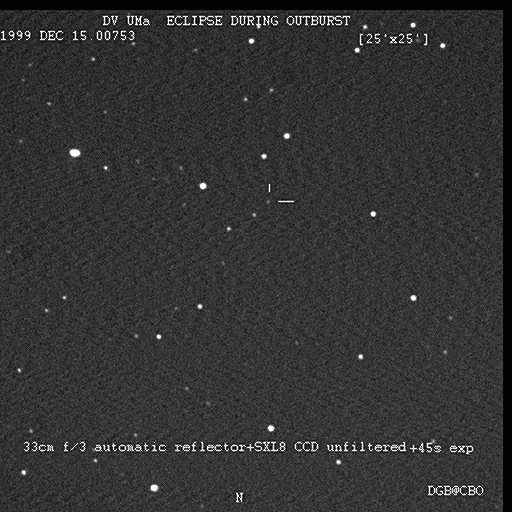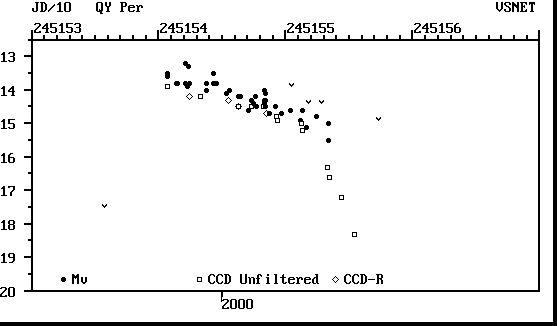
A 45 second image of DV Uma in eclipse during outburst, taken by Denis Buczynski at Condor Brow using his 33cm f/3 automatic reflector and an SXL8 unfiltered CCD camera
Deep eclipses of the order of 1.5 magnitudes were observed by several CCD observers, including Denis Buczynski at Condor Brow (see image below). The depth of these eclipses were identical to those observed during the 1997 superoutburst. In addition to these, large amplitude superhumps were detected by observers at Kyoto University (M. Uemura and T. Kato) and by Tonny Vanmunster (CBA Belgium), who reported superhumps of 0.5 magnitude which were observed on December 10/11 with a 0.35m f/6.3 telescope with an unfiltered SBIG ST-7 CCD camera.

A 45 second image of DV Uma in eclipse during outburst, taken by Denis
Buczynski at Condor Brow using his 33cm f/3 automatic reflector and an
SXL8 unfiltered CCD camera
Because the outburst was detected during the rise to maximum, Rudolph Novak (Nicholas Copernicus Observatory, Brno Czech Republic) was able to obtain early CCD photometry of the rising phase. He reports in vsnet-alert 3803 that early superhumps were detected on December 8th, along with eclipses of the accretion disc and a linear rise to maximum.
Further light curves and information on DV UMa eclipses can be seen at..
http://www.kusastro.kyoto-u.ac.jp/vsnet/DNe (including eclipse animations)
http://ian.cz/cba (CBA Brno homepage)
http://members.aol.com/GaryPoyner/DVuma.html (Visual observations of
eclipses during the 1997 outburst)
Links to these urls are on Other Web Sites
QY Per was discovered by Hoffmeister in 1966, and he recorded two outbursts photographically in September 1964 (mag 14.2) and October 1969 (mag 16.0). A further outburst was reported by Rosino on IAUC 4900 in October 1989 (mag 14.9). The first visual outburst was detected by Vanmunster in October 1994 (mv=14.0), and accurate astrometry was also performed during this outburst by Nick James. Further outbursts include Aug 1995 (mv=14.8) and July 1996 (mv=14.3).
The December 1999 outburst was intensely monitored by observers at Kyoto University. On vsnet-alert 3894, the Kyoto team reported their results from an 8.5 hour photometric run on December 30th. Superhumps with an amplitude of 0.3mag were detected, and a best superhump period was determined to be 0.0779 day. Data obtained by Gianluca Masi was also used in this analysis. Thus the long suspected UGSU status of this star was finally confirmed.

This light curve was compiled from BAAVSS observers reports (H. McGee, C.P. Jones, G. Poyner and W. Worraker) and observations posted to vsnet-obs. Congratulations to Mike Simonsen and Bill Worraker on their detection of this rare outburst.